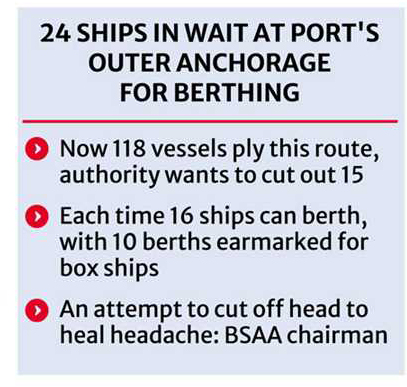Shipping jam, box-ship queues at Ctg seaport
Shippers oppose CPA move to reduce movement of vessels

Published :
Updated :

External trade may get in difficulty for a faceoff between the Chittagong Port Authority and shippers over the CPA move to lower the number of vessels plying the seaport channel to heal trade-decelerating congestions.
Sources said the port authority in a meeting on July 20 decided to lower the number of container vessels by 13 per cent from the existing number of ships plying to and fro. But Bangladesh Shipping Agents Association (BSAA) stands opposed to what they see as a trade-squeezing step.
Presently, 118 ships have the permission to ply the route and the authority now wants to cut the number by 15 to avoid queues of container vessels at the outer anchorage and demurrage-incurring ship-wait time off the channel.
The operator of the country's prime port says presently 16 vessels can take berth at the port of which 10 berths remain allocated for container ships.

When vessel plying increases at Chittagong port, the queue of ships at the outer anchorage becomes too long and their waiting time goes up. Moreover, if the loading and unloading of boxes at ships at the berth cannot be completed on time, the turnaround time of vessels also escalates.
As a result, image of the port to the international community gets tarnished. So, the authority wants to lower the number of vessels to port hosts.
On July 29, the port authority in a letter to the BSAA chairman asked for providing a list of 15 geared and gearless vessels within day to exclude from the eligibility list for plying the sea route.
Director (Traffic) of the CPA Enamul Karim told the July 20 meeting that, at the beginning of 2025, some 96 ships were operating to and from Chittagong Port. At the time, the waiting time at port's outer anchorage was one to two days while the number of waiting vessels there was seven to eight at best.
However, the authority later gave approval for the plying of some vessels on ad-hoc basis on different occasions, raising the number to 118.
To justify the pruning measure Mr Karim said, 'The rise in number of ships led to increased vessel congestions at the port, higher waiting time at outer anchorage, and a long queue of waiting ships there."
He suggests bringing down the number of vessels plying to and fro the port between 96 and 100 to ensure smooth operation of export-import activities in the country's prime seaport.
However, BSAA chairman Syed Mohammad Arif likens lowering the number of vessel to tide over congestions to an attempt to "chop off the head to heal headache".
He says the authority has to identify the reason of headache first before taking measures for remedy.
The port authority says congestion is an image factor for the port. But, at the same time, the reality is the port is not becoming looser for the congestions.
Mr Arif diagnoses the main reasons for recent congestion at the Chittagong port: long holidays for two Eids, strikes by the customs officials, disruption to ASYCUDA system, and strikes by vehicle drivers and owners.
"All these have chain affect on port's performance which led to congestions and ship queues at the port," he says, adding: "Due to these problems the turnaround time shot up to three days from two days in the past."
Also, Mr Arif wouldn't send any name of vessels to exclude from the eligibility list for plying the route. He further mentions various operational bottlenecks that have been contributing to the delays, including frequent gantry-crane breakdowns, trailer shortages, limited yard space, and equipment failures at the overflow yard.
"These issues are significantly impacting vessel productivity and turnaround times," he says, adding that the port authority should give attention to removing these hurdles to enhance operational efficiency instead of lowering number of vessels.
Port data show that on Wednesday some 24 container vessels were waiting at the outer anchorage of the Chittagong port while 12 ships loading and unloading boxes.
Some 41,128 twenty-foot-equivalent units (TEUs) of containers were lying at different yards of the port against the total storage capacity of 53,518 TEUs.


 For all latest news, follow The Financial Express Google News channel.
For all latest news, follow The Financial Express Google News channel.